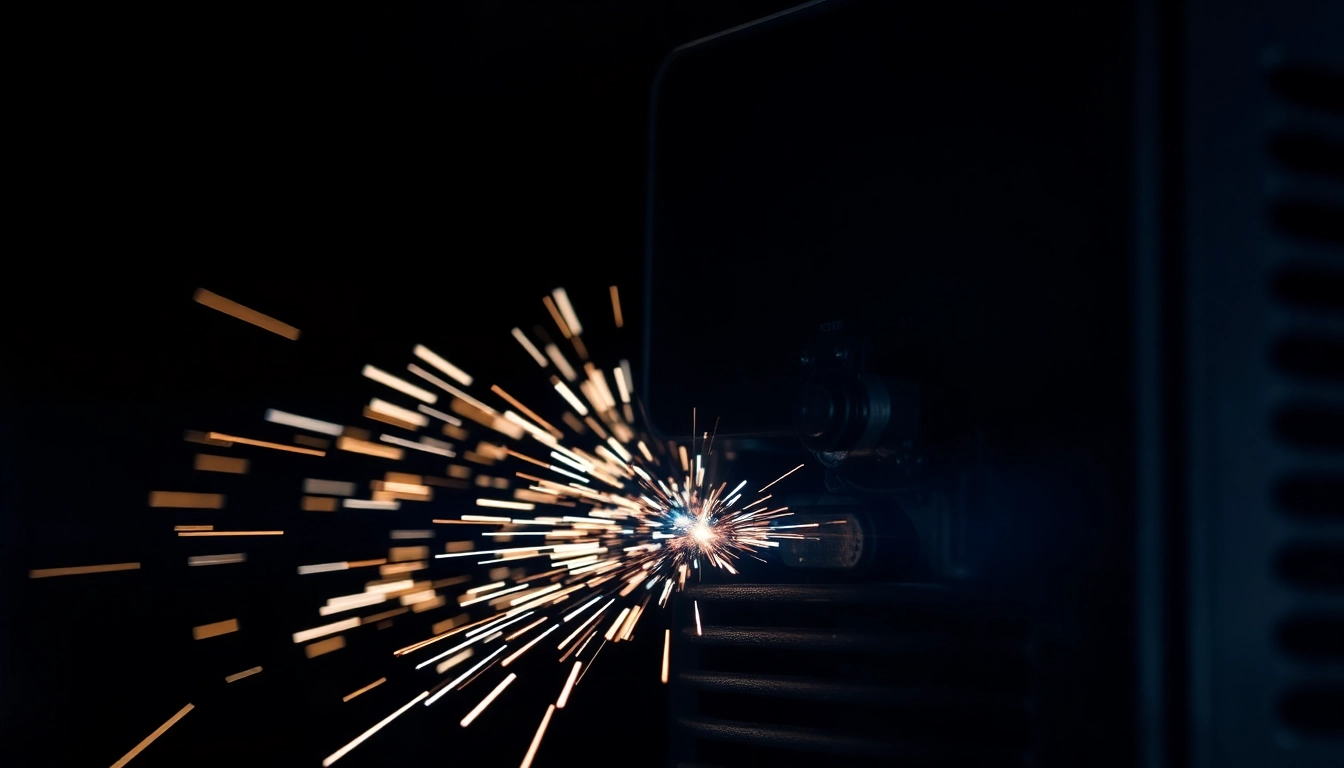Understanding Precision Die Cutting
In the fast-paced world of manufacturing, precision is paramount. One method that stands out for its accuracy and versatility is precision die cutting. This process enables manufacturers to produce complex shapes and components with high levels of precision. Let’s delve deeper into what precision die cutting entails, its benefits, and common applications.
What is Precision Die Cutting?
Precision die cutting is a specialized manufacturing process that utilizes sharp tools, or dies, to cut a variety of materials to the desired shape and size. Unlike traditional cutting methods, which often lack precision, this technique provides a high level of accuracy, ensuring that each piece meets exact specifications. The process can be applied to various materials, including paper, cardboard, plastic, foam, and metal, making it a flexible solution for many industries.
Benefits of Precision Die Cutting in Manufacturing
The advantages of precision die cutting are manifold, particularly in sectors where accuracy is essential. Key benefits include:
- High Accuracy: The use of specialized dies allows for a tight tolerance range, significantly reducing errors and the need for rework.
- Cost Efficiency: By cutting multiple shapes simultaneously, businesses can save on Material Waste and labor costs.
- Consistency: Once the die is created, the same high-quality output can be replicated consistently, ensuring uniformity across production runs.
- Versatility: Precision die cutting can be applied to a wide array of materials and industries, from packaging to automotive components.
- Rapid Prototyping: The ability to create prototypes quickly helps manufacturers test and modify designs before committing to full production.
Common Applications for Precision Die Cutting
Precision die cutting finds applications across various industries:
- Packaging: Custom-shaped packaging components are easily produced using precision die cutting, which enhances product appeal and protection.
- Automotive: Precise cuts are required for gaskets and thermal insulation components in vehicles.
- Medical Devices: The medical industry relies on precision die cutting to produce parts with tight tolerances for devices and equipment.
- Electronics: Components in electronic devices often require die-cut gaskets and insulation layers.
- Textiles: Producers can create intricate patterns and shapes in fabric materials for apparel and upholstery.
The Precision Die Cutting Process Explained
Steps Involved in Precision Die Cutting
The precision die cutting process involves several steps to ensure that the final product meets all specifications:
- Design and Development: The process begins with designing the part using CAD software to create precise specifications.
- Die Creation: Skilled technicians fabricate a die based on the design. This may involve milling or laser cutting metals to create the necessary cutting edges.
- Material Selection: Choosing the right material is crucial for achieving the desired performance and quality.
- Setting Up the Machine: The die is mounted onto the cutting machine, and the material is fed into the machine.
- Cutting: The machine activates, pressing the die against the material to make the cuts. Monitoring of the process ensures quality and accuracy.
- Inspection: Finished pieces are inspected for quality assurance, ensuring they meet specifications.
Types of Materials Used in Precision Die Cutting
A wide variety of materials can be utilized in precision die cutting, including:
- Paper and Cardboard: Commonly used for packaging and printing applications.
- Plastics: Including PET, PVC, and polycarbonate, often used in packaging, electronics, and medical fields.
- Foam: Used extensively for cushioning and insulation in packaging.
- Metals: Thin sheets of metals are cut for use in automotive and electronic components.
- Textiles: Fabrics for clothing and upholstery can also be die-cut to precise dimensions.
Choosing the Right Die Cutting Machine
Selecting the appropriate die cutting machine is critical for maximizing efficiency and output quality. Factors to consider include:
- Type of Material: Ensure the machine can handle the specific materials you intend to cut.
- Production Volume: Different machines are suited for varying production scales, from short runs to high-volume outputs.
- Precision Requirements: Machines vary in their capability to achieve tight tolerances; selecting one that meets your specifications is essential.
- Cost and Maintenance: Consider initial costs as well as long-term maintenance needs and expenses.
Quality Control in Precision Die Cutting
Standards for Quality in Die Cutting
Maintaining high-quality standards is crucial in precision die cutting. Various industry standards can guide producers toward achieving optimal quality, including ISO 9001 for quality management systems and ASTM standards for materials.
Measuring Tolerances and Accuracy
Tolerances in die-cut parts are vital for ensuring that each piece fits correctly within its intended application. Standard tolerances typically fall within ±0.005 inches depending on the material and complexity, with some specialized processes achieving even greater precision. Accurate measurement tools and techniques are essential in the quality control process, which often includes inspections using calipers and coordinate measuring machines (CMM).
Common Quality Issues and Solutions
Quality issues can arise during the precision die cutting process. Common problems may include:
- Inaccurate Cuts: Often caused by a worn die or misaligned machinery. Regular maintenance and calibration are necessary.
- Material Fraying: Cutting too quickly or with dull blades can lead to frayed edges. Adjusting blade sharpness and cutting speed helps mitigate this.
- Dimensional Variance: Variance can occur due to material swelling or environmental factors. Utilizing controlled environments and regularly checking material quality can help.
Comparing Die Cutting Techniques
Rotary vs. Flatbed Die Cutting
Rotary and flatbed die cutting are two common methods, each with distinct advantages. Rotary die cutting utilizes a rotating cylinder to make continuous cuts and is best for high-speed and high-volume applications. In contrast, flatbed die cutting employs a flat surface where the die is pressed onto the material, making it more suitable for intricate designs and lower volume runs. Understanding the specific needs of your production process will help determine which technique is most appropriate.
The Role of Laser Cutting in Precision Applications
Laser cutting has emerged as a popular alternative to traditional die cutting methods, offering a high degree of flexibility and precision. This technique uses a focused laser beam to cut materials, allowing for complex shapes and less material waste. While laser cutting is effective for prototypes and custom parts, it may not be as economical for high-volume production when compared to traditional die cutting methods.
Advantages of Precision Die Cutting Over Other Methods
Precision die cutting offers several advantages over other cutting methods:
- Higher Efficiency: By cutting multiple layers at once, precision die cutters can produce large quantities rapidly.
- Consistency in Quality: Die cutting ensures uniform pieces, which may be difficult to achieve with manual cutting methods.
- Versatile Material Usage: It can effectively cut various materials that other methods may struggle with.
- Lower Production Costs: Over time, the cost per unit decreases as batch sizes increase, making precision die cutting an economically sound choice for many manufacturers.
Future Trends in Precision Die Cutting
Technological Advancements on the Horizon
The landscape of precision die cutting is continually evolving, driven by advancements in technology. Innovations such as automated die cutting systems, IoT integration for monitoring production efficiency, and the use of AI for optimizing cutting paths are set to enhance precision, speed, and material efficiency. These technological improvements will likely lead to more rapid advances in the capabilities and applications of precision die cutting.
Sustainability in Die Cutting Practices
As environmental concerns rise, sustainability has become a critical focus in manufacturing. Precision die cutting practices are also evolving to include more sustainable options, such as using eco-friendly materials and applying methods that reduce waste and energy consumption. Implementation of recycling practices for scrap materials is encouraged to create a circular economy in manufacturing.
Customization Trends in Precision Die Cutting
Customization continues to be a key trend, with an increasing demand for personalized products across many sectors. Precision die cutting is uniquely positioned to meet this demand, offering capabilities to produce items tailored to specific customer needs. Companies that can efficiently produce small, customized batches while maintaining high quality will have a competitive edge in the market.


